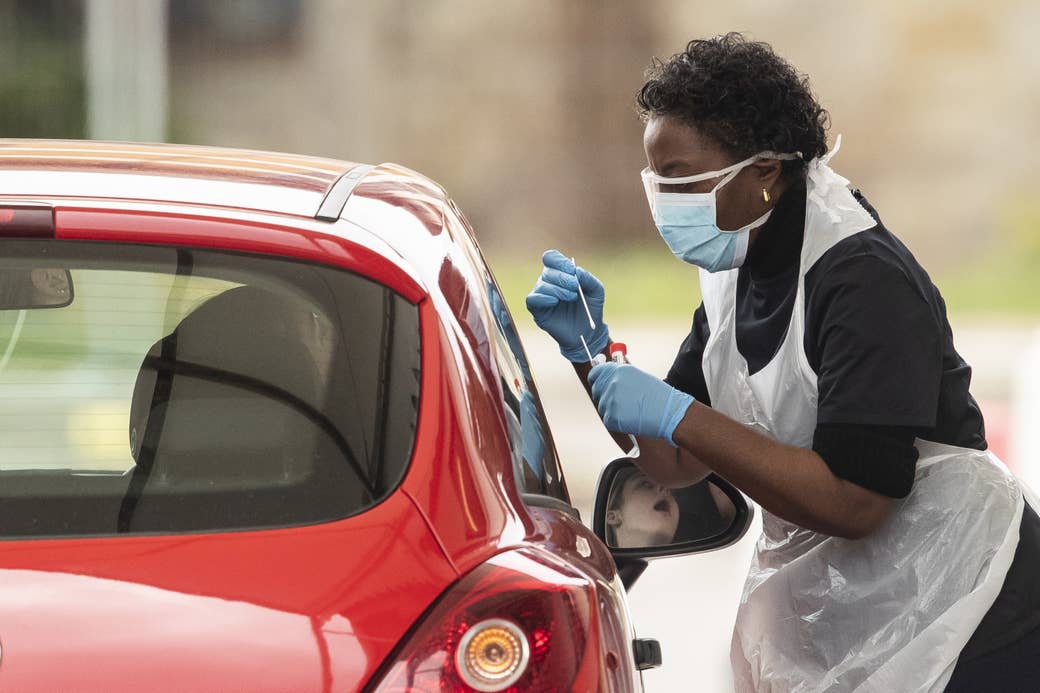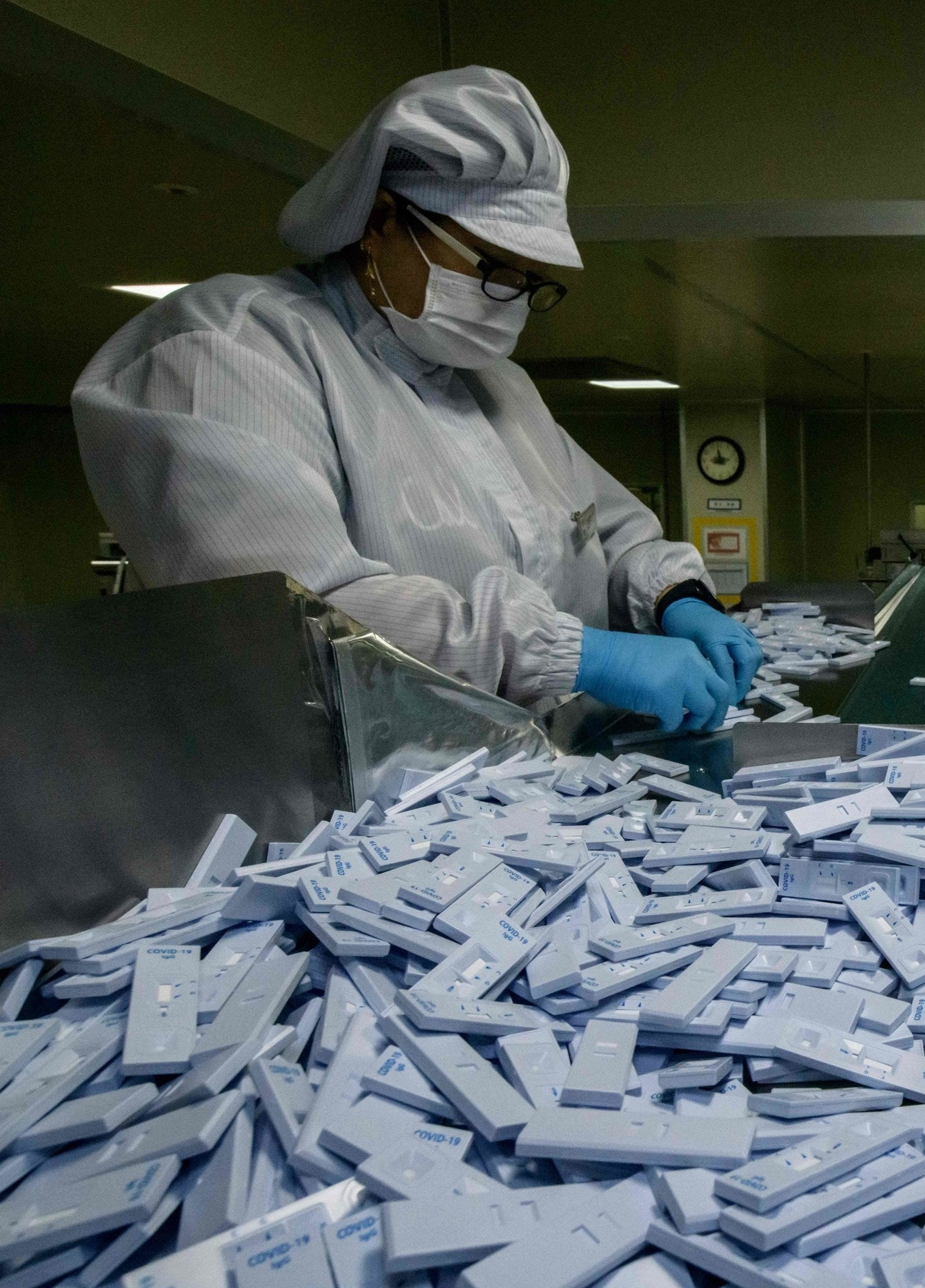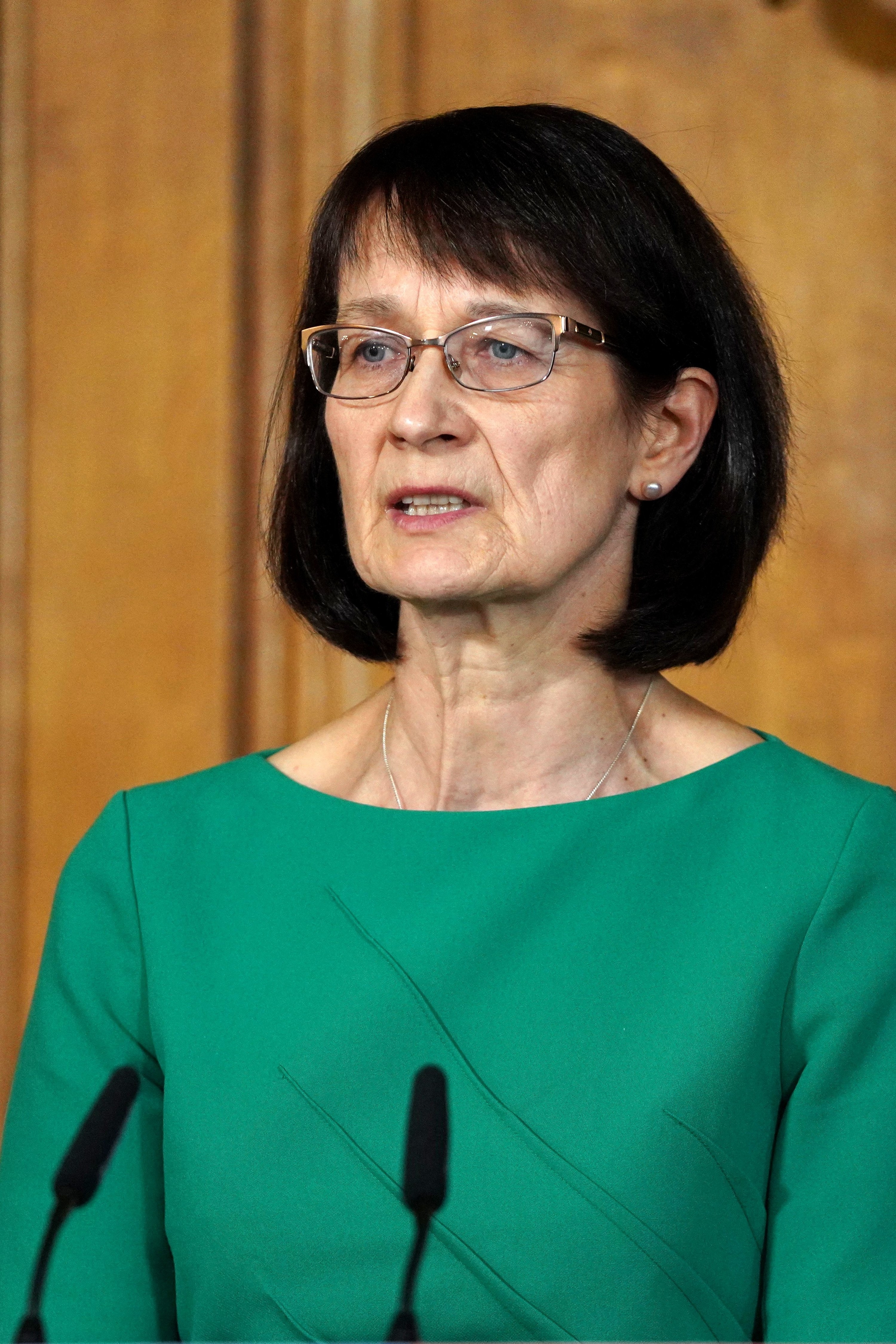
The journalists at BuzzFeed News are proud to bring you trustworthy and relevant reporting about the coronavirus. To help keep this news free, become a member and sign up for our newsletter, Outbreak Today.
It is the question everyone is asking: Why is the UK testing less than other major countries?
The public position of Boris Johnson’s government — amid mounting political pressure this week — has been to defend its record on coronavirus testing. Britain is carrying out more tests than much of Europe, health secretary Matt Hancock has insisted, it is “ramping up” the number of tests being carried out, and is now able to test 10,000 people per day.
But look at other major economies and that “ramping up” defence does not appear to stand up to scrutiny.
Germany is currently expecting to test half a million people per week. The US, even after the extreme criticism Donald Trump has received over his handling of the pandemic — and on testing specifically — has now surpassed the UK on tests per capita. Yet Britain’s ambition is still only to hit 25,000 daily tests within the next three weeks.
BuzzFeed News has spoken to health experts in the UK and across Europe to find out why. The answer, they said, stemmed from Britain’s controversial initial strategy of mitigation of the virus (rather than suppression), rendering testing a secondary concern — an approach which has also contributed to a lack of preparedness and the capacity to carry out tests at scale.
The UK’s mitigation approach was devised by England’s chief medical officer Chris Whitty, and chief scientific adviser, Patrick Vallance. According to a person who has spoken to Whitty and Vallance, they took the view that the UK should not attempt to suppress the outbreak entirely, but rather prioritise protecting the elderly and vulnerable and ensuring the NHS did not become overwhelmed, while allowing the rest of population to build up “herd immunity”.
This strategy meant that widespread testing of every coronavirus case was not a priority for the UK, the person said, since the government’s scientists were assuming that between 60% and 80% of the population would become infected.
Accordingly, no preparations were made to increase manufacturing or imports of testing kits, nor to expand the UK’s laboratory capacity. Imports of testing kits are now extremely difficult as other nations seek more than ever to keep them for their own use.
On Tuesday, the Times reported that a global shortage of key chemicals used for testing meant that some NHS hospitals were having to “home brew” their own. Speaking at the government's daily press conference later that day, cabinet office minister Michael Gove confirmed that the supply of chemicals was an issue.

The government has publicly insisted that herd immunity is not the UK’s policy. But the person familiar with Whitty and Vallance’s thinking said they believed it privately remains a long-term objective.
They said they thought the government would continue to prioritise increasing intensive care unit capacity to prevent the NHS from becoming overwhelmed, rather than widespread testing of the population, because they had accepted that a large percentage of the country will become infected in the next 12 to 18 months, before a vaccine is found.
The focus on testing NHS staff rather than communities, and on producing an antibody test rather than mass manufacturing more COVID-19 tests, were evidence of this, they argued.
Even if the UK had wanted to introduce German-style mass testing of the population, its lack of preparedness and capacity for this kind of pandemic would make that very difficult, according to an analysis of data and testimony from medical experts.
One data point lays bare the UK and Germany’s very different approach to testing: The NHS said on Monday night that more than 9,000 people who have COVID-19 are now being treated in hospitals across England, which equates to roughly one in two of those that have tested positive for the virus, underlining that the UK has been focussing its tests on the sickest people.
Germany has cast its testing net far wider. In North-Rhine Westphalia, the country’s largest state and one of the worst affected by the disease, only 258 out of 4,479 infected were hospitalised by March 20, according to local authorities cited by the Wall Street Journal.
The data tells a clear story: The UK’s numbers and aspirations fall well short of other major economies. As of Saturday, the US had 2,248 tests per million compared to the UK’s 1,922.59 tests per million, according to the COVID tracking project.
Last week, Germany is thought to have carried out about 500,000 tests, according to the virologist Christian Drosten, who has been advising the federal government throughout the crisis. The week before that, the country carried out nearly 350,000 tests and the week before that it did some 127,500 tests, figures published by the Robert Koch Institute (RKI), which collects and publishes Germany’s COVID-19 data, show.
Drosten has recently highlighted Germany's network of laboratories as a factor contributing to early detection of the coronavirus. The RKI says that the results it collects come from 174 labs.
Other countries that have tested at scale have similar levels of both test and dedicated lab numbers. South Korea, which has been running about 20,000 tests a day for some time, was quick to develop — and launch within weeks — a network of hundreds of testing sites and 96 labs to process the results, the BBC has reported.
South Korean foreign minister Kang Kyung-wha told the British broadcaster that 268,000 South Koreans had been tested for the virus — about one in every 200 citizens — as of 15 March.

Both German and South Korean officials and experts have stressed the importance of mass testing behind their respective approaches to fighting the coronavirus.
The UK’s lab capacity dedicated to COVID-19, and the way those labs are structured, appears not to have been geared up enough to handle the scale of the pandemic.
Public Health England has expanded its testing capacity from one to 12 labs and is supporting the NHS to test at greater capacity in their 29 laboratory networks — which a spokesperson described as "the fastest deployment of a novel test to PHE and NHS labs in recent history, including in the Swine flu pandemic in 2009”.
But the UK has a more centralised approach to lab testing compared to Germany, and this has limited its ability to scale and process results at the same speed as other countries, despite its efforts to ramp up capacity.
“The roll-out of additional capacity requires properly trained staff, equipment and a supply of consumables as well as a thorough validation process for the lab to ensure the results are correct,” the PHE spokesperson added.
Explaining the UK’s setup, professor Sharon Peacock, the director of the national infection service at Public Health England (PHE), told a Science and Technology Committee hearing of MPs last week: “Laboratories in this country have largely been merged, so we have a smaller number of larger laboratories. The alternative is to have a single large testing site. From my perspective, it is more efficient to have a bigger testing site than dissipating our efforts into a lot of laboratories around the country.”
Greg Clark, the Tory MP who chairs the committee, told BuzzFeed News: "We have lots of labs in this country, we are scientifically a very well endowed country. We have many universities across the country, the vast majority of which have laboratories that can test, so it’s not that we have less capacity than others it's that we took an approach of having tests done in a very centralised way, first of all at a single laboratory and then rolled out to 12 public health laboratories and only recently involving hospital labs and others in universities."
He added: "Our resources are not significantly less than Germany and it wouldn’t surprise me if we were ahead of them but we didn’t deploy them until relatively late in the pandemic."
All positive tests in the UK were initially validated by one PHE lab in Colindale, north-west London, though a PHE spokesperson said that was no longer the case.
The UK approach to testing was revised as the virus spread. When the first few coronavirus cases hit the UK in January, Public Health England began a strict programme of contact tracing and testing potential cases. This early testing enabled the UK to “gain 3 or 4 weeks on Italy”, according to a source familiar with the government’s approach.
This was similar to the more aggressive efforts that are continuing in Germany, South Korea and elsewhere. But the UK policy changed after a few weeks when Britain started to run out of testing kits and lab capacity, and its senior government scientists moved from what they called the “contain” phase to the “delay phase”, the source said.
Instead of testing, the UK government decided to prioritise intensive care unit and ventilator capacity at hospitals, believing that this was the best way to save the lives of those worst affected by the disease, rather than widespread tests, two sources told BuzzFeed News.
Prioritising ICU capacity and ventilator procurement over testing was the right strategy, the second source argued, because while data on overall cases may be useful overall, it is a secondary concern compared to ensuring the elderly and vulnerable can receive treatment.
Although the UK is now increasing testing following widespread criticism, that new capacity will be focused primarily on NHS workers so they can keep working, rather than the general population, one of the sources said. Data from the areas hardest hit by the outbreak, such as Italy and Spain, shows that frontline health workers are among the worst affected.
Speaking at Tuesday evening's government press conference, deputy chief medical officer Jenny Harries confirmed that the UK would prioritise its testing on NHS clinicians rather than the wider public. Most of those who would test positive would not require treatment, Harries said, so it would not be the best use of resources.
At the science committee last week, Imperial College professor Neil Ferguson, who has been a key adviser to the government on the COVID-19, explained: "Testing has always been discussed significantly. The reason it was not included in initial modelling was about the projections by PHE of how quickly this country could ramp up testing capacity.
“If we have to transit from the suppression strategy and the lockdown strategy to something this country can maintain long term, undoubtedly much more widespread testing, contact tracing and other methods will have to be deployed.
“If we are talking about back in January/February/early March, it was very clear from messages from Public Health England that we would have nowhere near enough testing capacity to adopt that strategy."
This testimony was endorsed by one of the health sources who spoke to BuzzFeed News. The UK had a “massive shortage of tests”, they said, and was simply unable to replicate the testing capabilities of other countries at the moment.

The WHO has been pushing governments constantly for widespread testing, but last week, Harries claimed the advice didn’t apply to the UK, prompting criticism from some experts within the British medical community and a rebuke by the WHO.
She said: “We need to realise that the clue for WHO is in its title, it’s a ‘world’ health organisation, and it is addressing all countries across the world with entirely different health infrastructures, and particularly public health infrastructures. We have an extremely well-developed public health system in this country.
“The point there is that they are addressing every country including low and middle-income countries, encouraging all countries to test of some type,” she said.
“There comes a point in a pandemic when [testing of every case] is not an appropriate intervention and that is the point where we moved,” Dr Harries went on. “Although we still do some contact tracing and testing, for example in high-risk areas like prisons and care homes, that is not an appropriate mechanism as we go forward.”
Clark, the Conservative MP who chairs the science and technology committee, told BuzzFeed News: “I was struck by that comment. I guess in order to clarify that we need to go back to the WHO to see if that’s what they did mean. But it is notable that Germany has chosen to do a lot of testing. They’re not a developing country.”
Asked about the remarks, a WHO spokesperson said: “To defeat the virus, WHO urges all countries to implement aggressive and targeted tactics. Aggressive measures to find, test, isolate and treat cases, and trace contacts are not only the best and fastest way out of social and economic restrictions – they’re also the best way to prevent them.”
Devi Sridhar, professor and chair of global public health at Edinburgh University, said: "The World Health Organisation aims to support all countries across the world, and its advice on response to COVID should be taken seriously by all countries given it is aiming to foster cross-country learnings and support the most evidence-based interventions. Germany for example is following WHO testing advice."
Limited testing also means that the quality of statistics — and the world’s knowledge of the disease — is incomplete.
Countries that have been able to test at scale, such as Germany and Iceland, have found that the average age of those testing positive is lower than in those countries where testing is focussed on people who are hospitalised or have worse symptoms. This is partially explained by the fact that many of those who test positive will have mild symptoms or no symptoms at all, but they still have the ability to spread the virus.
The breadth of testing is also one of the main theories behind the fact that the COVID-19 death rate is currently lower in Germany, compared to Italy and Spain where efforts have had to mostly focus on those in hospital as the virus grew exponentially.
Why is the #COVID19 mortality rate in Germany relatively low?
In an interview with the German newspaper Zeit, the German virologist, Drosten, noted that as the number of cases rises in Germany testing capacity may not be able to keep up. One of the consequences of this will be that the fatality rate in Germany will rise, but this would be a statistical distortion, he said. “It will simply reflect what's already starting to happen: We're missing more and more infections.”
When that happens, Drosten added, it may become necessary to take “short cuts”, such as considering an entire household positive if one family member gets infected, or prioritise testing on the basis of symptoms.
The UK’s approach to testing may be proven right — we just don’t know. But it has taken a different path to most.




